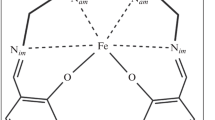Abstract
Various compositions of oxo derivatives of iron reacting with sodium peroxide have been studied by Mössbauer spectroscopy. We have examined several mathematical models of the measured spectra. The results obtained are inconsistent with hypotheses made previously that such conditions may lead to the formation of compounds of iron in oxidation states above (6+). We demonstrate that a large excess of an alkali peroxide leads, most likely, to the formation of at least two iron(V) derivatives in tetrahedral coordination. In their Mössbauer spectra, they have isomer shifts of −0.45 and −0.51 mm/s and unusually large quadrupole splittings: 1.32 and 1.94 mm/s (at room temperature).
Similar content being viewed by others
References
Riedel, S. and Kaupp, M., The highest oxidation states of the transition metal elements, Coord. Chem. Rev., 2009, vol. 253, p. 606.
Wilke, M., Farges, F., Petit, P.-E., et al., Oxidation state and coordination of Fe in minerals: An Fe K-XANES spectroscopic study, Am. Mineral., 2001, vol. 86, p. 714.
Perfiliev, Yu.D., Benko, E.M., Pankratov, D.A., et al., Formation of iron(VI) in ozonolysis of iron(III) in alkaline solution, Inorg. Chim. Acta, 2007, vol. 360, p. 2789.
Jeannot, C., Malaman, B., Gérardin, R., and Oulladiaf, B., Synthesis, crystal and magnetic structures of the sodium ferrate(IV) Na4FeO4 studied by neutron diffraction and Mössbauer techniques, J. Solid State Chem., 2002, vol. 165, no. 2, p. 266.
Dedushenko, S.K., Perfiliev, Yu.D., Tcheboukov, D.E., et al., Moessbauer study of pentavalent iron in vanadium(V) oxide matrix, Mendeleev Commun., 1999, vol. 5, p. 211.
Demazeau, G., Buffat, B., Menil, F., et al., Characterization of six-coordinated iron(V) in oxide lattice, Mater. Res. Bull., 1981, vol. 16, p. 1465.
Gutsev, G.L., Khanna, S.N., Rao, B.K., and Jena, P., FeO4: A unique example of a closed-shell cluster mimicking a superhalogen, Phys. Rev. A, 1999, vol. 59, no. 5, p. 3681.
Goralevich, D.K., Studies of higher group VIII oxygen compounds, Zh. Ros. Fiz.-Khim. O-va, Ser. Khim., 1926, vol. 58, no. 8, p. 1129.
Perfil’ev, Yu.D., Kopelev, N.S., Kiselev, Yu.M., and Spitsyn, V.I., Mössbauer study of octavalent iron, Dokl. Akad. Nauk SSSR, 1987, vol. 296, no. 6, p. 1406.
Dedushenko, S.K., Perfil’ev, Yu.D., and Kornilova, A.A., RF Patent 2 448 055.
Dedushenko, S.K., Perfil’ev, Yu.D., Chuev, M.I., et al., Identification of iron oxidation states in the products of interaction of Na2O2 and Fe2O3 by Mössbauer absorption spectroscopy, Russ. J. Inorg. Chem., 2010, vol. 55, no. 6, p. 942.
Afanas’ev, A.M. and Chuev, M.A., Discrete versions of Mössbauer spectra, Zh. Eksp. Teor. Fiz., 1995, vol. 107, no. 3, p. 989.
Cooper, G.D. and DeGraff, B.A., Photochemistry of ferrioxalate system, J. Phys. Chem., 1971, vol. 75, no. 19, p. 2897.
Matsnev, M.E. and Rusakov, V.S., Spectrrelax: An application for Mössbauer spectra modeling and fitting, AIP Conf. Proc., 2012, vol. 1489, p. 178.
Kopelev, N.S., Kiselev, Yu.M., and Perfiliev, Yu.D., Mossbauer spectroscopy of the oxocomplexes iron in higher oxidation states, J. Radioanal. Nucl. Chem., 1992, vol. 157, p. 401.
Menil, F., Systematic trends of the 57Fe Mossbauer isomer shifts in (FeOn) and (FeFn) polyhedra. Evidence of a new correlation between the isomer shift and the inductive effect of the competing bond T-X (→Fe) (where X is o or F and T any element with a formal positive charge), J. Phys. Chem. Solids, 1985, vol. 46, p. 763.
Takeda, Y., Kanno, K., Takada, T., et al., Phase relation in the oxygen nonstoichiometric system, SrFeOx(2.5 ≤ x ≤3.0), J. Solid State Chem., 1986, vol. 63, p. 237
Walker, L.R., Wertheim, G.K., and Jaccarino, V., Interpretation of the Fe57 isomer shift, Phys. Rev. Lett., 1961, vol. 6, no. 3, p. 98.
Neese, F., Prediction and interpretation of the 57Fe isomer shift in Mossbauer spectra by density functional theory, Inorg. Chim. Acta, 2002, vol. 337, p. 181.
Filatov, M., First principles calculation of Mossbauer isomer shift, Coord. Chem. Rev., 2009, vol. 253, p. 594.
Shinjo, T., Ichida, T., and Takada, T., Fe57 Mossbauer effect and magnetic susceptibility of hexavalent iron compounds; K2FeO4, SrFeO4 and BaFeO4, J. Phys. Soc. Jpn., 1970, vol. 29, no. 1, p. 111.
Wallace, T. and Fleck, A., Some properties of fused sodium hydroxide, J. Chem. Soc., 1921, vol. 119, p. 1839.
Gutsev, G.L., Weatherford, C.A., Pradhan, K., et al., Structure and spectroscopic properties of iron oxides with the high content of oxygen: FeOn and (n = 5–12), J. Phys. Chem. A, 2010, vol. 114, no. 34, p. 9014.
Tran, V.T. and Hendrickx, M.F.A., Description of the geometric and electronic structures responsible for the photoelectron spectrum of FeO −4 , J. Chem. Phys., 2011, vol. 135, paper 094 505.
Atanasov, M., Theoretical studies on the higher oxidation states of iron, Inorg. Chem., 1999, vol. 38, p. 4942.
Pankratov, D.A., Komozin, P.N., and Kiselev, Yu.M., EPR spectroscopy of transformations of iridium(III) and iridium(IV) hydroxo complexes in alkaline media, Russ. J. Inorg. Chem., 2011, vol. 56, no. 11, p. 1794.
Pankratov, D.A., Dement’ev, A.I., and Kiselev, Yu.M., Ab initio calculations of hydroxoplatinum compounds: II. Binuclear platinum(IV) superoxo complexes, Russ. J. Inorg. Chem., 2008, vol. 53, no. 2, p. 247.
Ippolitov, E.G., Tripol’skaya, T.A., Prikhodchenko, P.V., and Pankratov, D.A., Potassium hexahydroperoxostannate: Synthesis and structure, Russ. J. Inorg. Chem., 2001, vol. 46, no. 6, p. 851.
Pankratov, D.A., Prikhodchenko, P.V., Perfil’ev, Yu.D., et al., Mössbauer spectroscopy of alkali hydroperoxostannates, Izv. Ross. Akad. Nauk, Ser. Fiz., 2001, vol. 65, no. 7, p. 1043.
Josephson, B.D., Temperature-dependent shift of Γ-rays emitted by a solid, Phys. Rev. Lett., 1960, vol. 4, p. 341.
Author information
Authors and Affiliations
Corresponding author
Additional information
Original Russian Text © D.A. Pankratov, 2014, published in Neorganicheskie Materialy, 2014, Vol. 50, No. 1, pp. 90–98.
Rights and permissions
About this article
Cite this article
Pankratov, D.A. Mössbauer study of oxo derivatives of iron in the Fe2O3-Na2O2 system. Inorg Mater 50, 82–89 (2014). https://doi.org/10.1134/S0020168514010154
Received:
Published:
Issue Date:
DOI: https://doi.org/10.1134/S0020168514010154




